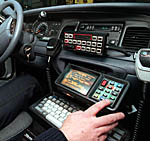January 21, 1999
A Well-Equipped Patrol Officer: Gun, Flashlight, Computer
By CATHERINE GREENMAN
f you're ever stopped in your own car for speeding or making an illegal U-turn, chances are the police officer pulling you over will know your name before even getting out of the patrol car.
No, the officer is not a member of a psychic cops network. While trailing you, however, the officer types your license plate number into a small computer to find out about your vehicle. Such computers, called mobile data terminals, sit between the driver's seat and the front passenger seat in the 2,000 marked police patrol cars in New York City.

Computers on Patrol Have Got Your Number
Digital dispatching is changing the way police officers in New York City do their jobs. One of the tools is the mobile data terminal, or M.D.T., which can be used by an officer on patrol to send and receive various types of information.
Next...Mobile data terminals, or M.D.T.'s, will also be used by the New York police for other purposes, like speeding response times to 911 calls. Currently, if you dial 911 in New York City to report an assault taking place outside your window, the 911 operator who takes your call will enter the location, and any other information you give, into a computer-aided dispatch, or Cad, system. Within seconds, a 911 dispatcher in the same building, in downtown Brooklyn, retrieves this information from the Cad system and reads it over a two-way radio to a police squad car, directing the car to the site of the incident. Depending on various factors, this process can take seconds or minutes.
The plan is for the 911 operator receiving an emergency call to type the information directly into the M.D.T. system, which should shorten the response time.
Moving to a digital dispatch system will get more information out to more officers faster, said Lieut. Ted Dempsey of the Office of Technology and Systems Development at the New York City Police Department. It will also clear the congested radio bands used by dispatchers for emergencies.
"There will always be a need for radio communication," Lieutenant Dempsey said. "But we're hoping to take the bulk of our communication online through the M.D.T.'s within a couple of years. By then, the system will be used by officers to get the details of the job, to acknowledge they've received the job and to let the dispatcher know they've arrived on the scene."
An M.D.T. lets a patrol officer have access to vehicle and driver information without going through a dispatcher. "It used to be that to find anything out about motor vehicles, driver's license records or normal car stop stuff," said Sgt. Joseph Grogan of the 18th Precinct in Manhattan (Midtown North), "we would have to ask a dispatcher, who was busy as an octopus just handing out workloads to cars, to stop and run a separate license or plate check, while life out there was flying by. Now we can run checks in our cars by ourselves, and it takes just a few seconds."
Lieutenant Dempsey said that long-range plans called for expanding the kind of information available to officers using M.D.T.'s from the New York State Police Information Network. "If there's an incident in a school after hours, for example, the patrol car will be able to pull up the building hours of operation, the name of the superintendent on duty, as well as a record of any other incidents in the neighborhood around that time," Lieutenant Dempsey said. "This is information that the radio dispatcher doesn't have the time to look up."
The M.D.T. network lets an officer broadcast instant messages to other officers in the division.
M.D.T.'s also help officers keep what they know quiet."If you radio in a guy's name while your partner's got him against the wall and the dispatcher radios back a message that he's wanted, the guy will be able to hear all the information you've just received and try harder to make a break on you," said Officer Randy Gaines. "But when you do a name check via an M.D.T. and get the information sent back digitally, you're not giving the guy a clue about what you know."
For this reason, the Police Department is talking with a number of handheld-computer manufacturers about supplying officers on foot with portable M.D.T.'s.
The M.D.T.'s in patrol cars also allow officers to communicate with one another.
In an environment that resembles an online chat room, the M.D.T. network lets an officer broadcast instant messages to other officers in the division and respond to questions like the location of the A.S.P.C.A. or the correct procedure for a parking summons during a parade.
Lieutenant Dempsey said a strict policy prohibited unauthorized personal messages, although the occasional Yankee score or lunch plan slipped through.
This is a far cry from the late 1970's, when the first M.D.T.'s were installed in several patrol cars in Atlantic City. (The first M.D.T.'s were installed in New York City in 1986.) John McFadden, vice president for sales in Motorola's wireless data division, which supplies the New York police with M.D.T.'s, said it had taken a few years for officers to get used to using the computers.
"In the beginning, they complained that they weren't secretaries and that they didn't want to learn how to type," McFadden said. "It took them a while to see the value in it."